A Hair Transplant Alternative that Also Benefits Hair Transplants
The overwhelming majority of TrichoStem® Hair Regeneration patients are satisfied with the results of thickening of their thinning hair, and managing further hair loss such that they are able avoid hair transplant surgery for the time being. TrichoStem® Hair Regeneration can be a hair transplant alternative for the right candidate. For people with advanced hair loss where most of the hair has already disappeared, a hair transplant is needed to put hair in completely bald areas that are skin-smooth for 3-5 years.
The Nature and Limitations of Hair Transplant Surgery
Hair transplantation, whether it be using the follicular unit transplantation (FUT) method, or the follicular unit extraction (FUE) and its iterations (robot, punch graft, etc.), are surgical procedures with their own risks and limitations. As a surgical procedure, hair transplantation does involve a certain amount of trauma to the scalp; has a critical period of recovery and healing that helps determine successful results; and hair grafts, like all grafting procedures, do not all survive the harvesting and transplanting processes.
Hair transplants in general are limited procedures by total number. The amount of hair that can be transplanted, no matter how successful or aggressive the graft harvest is, will never equal the amount of hair lost. About 1500-3000 grafts can be harvested for transplant. With a full head of hair at its peak numbering about 100,000 hairs during the early teens, and about half being lost when hair loss is first realized, hair transplants can never replace the total amount of hair lost. Progressive hair loss also continues after a transplant. Compounding hair transplant limitations is natural hair density numbers from 35-100 hairs per square centimeter. However, a square centimeter of scalp only has the blood supply to sustain 20 transplanted hairs per square centimeter. In other words, hair transplants are not only limited by the total grafts that can be harvested, but there is also a limit of how densely grafts can be implanted in a given space in a single transplant session.
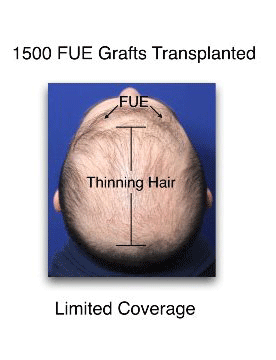
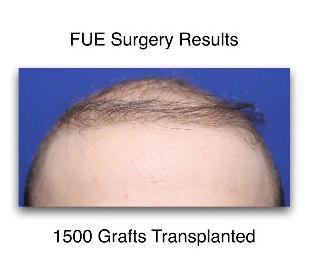
1500 GRAFTS MAY SOUND LIKE A LOT, BUT IN REALITY IT COVERS A VERY SMALL AMOUNT OF SCALP WITH VERY LIMITED DENSITY. THE AMOUNT OF GRAFTS, EVEN IF DOUBLE THE AMOUNT, CANNOT MATCH THE HAIR THAT’S BEEN LOST.
Some hair transplant practices claim they can harvest 4000 or more grafts, and place 50-100 grafts per square centimeter, which technically can be done. However, those numbers don’t mean much that all the grafts will survive. Transplanting this many grafts are known as “mega sessions” and can result in up to 90% of grafts not surviving past the short-term.
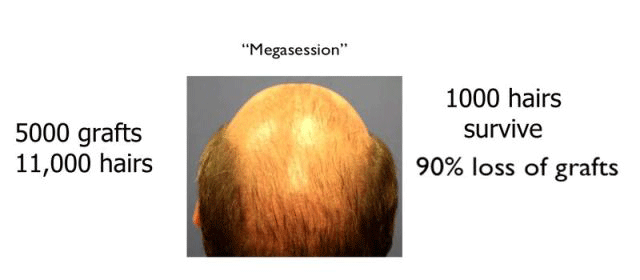
Be careful of hair transplant clinics promising any more than 3000 grafts per session. Graft, implant, and density numbers can be skewed when survival of grafts are not taken into account.
Why TrichoStem® is a better option than Hair Transplant and How TrichoStem® Hair Regeneration Can Improve Hair Transplantation
Improving Graft Survival
TrichoStem® Hair Regeneration is primarily composed of two wound healing materials: extracellular matrix by ACell (ECM) and platelet-rich plasma (PRP). The effects of extracellular matrix on hair growth was first observed when it was used to heal transplanted areas of the scalp and the donor area. The first 48 hours after a hair transplant are critical for the overall success of a hair transplant. Maximizing survival of hair grafts gives more coverage and density, and optimizes the value of a hair transplant. Healing the donor strip area at the back of the head to provide a natural appearance and ensuring a greater supply of donor hair if future hair transplants are needed.
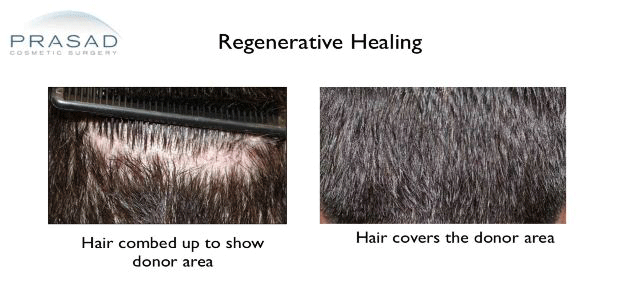
TrichoStem® Hair Regeneration with its two wound healing materials (PRP+ECM) is used after hair transplant surgery (FUT) to heal the donor strip for a natural appearance and to restore donor hair.
Increasing Hair Density by Thickening Existing Hair
In many hair transplant cases, native hair still exists and grows. However, native hair at the top of the scalp and crown area are still prone to hair thinning and hair loss. Like the hair that was already lost, if left untreated, native hair will also continue to thin until it disappears. Perhaps the greatest misconception of hair transplantation is that it will prevent future baldness. Hair transplants do not stop hair loss, and the evidence can be seen by visible hair plugs in hair loss patients whose hair looked more dense soon after a transplant, but gradually lost the surrounding hair, leaving only transplants behind.
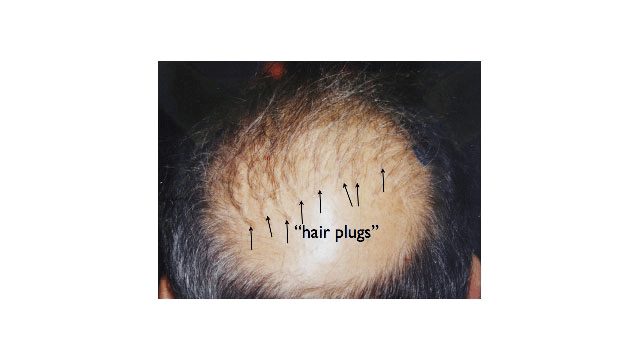
Hair plugs are visible when transplanted hair remains, but native hair around it has thinned out and disappeared. Hair transplants do not stop progressive hair loss, so treatments like TrichoStem® Hair Regeneration are needed with hair transplants to prevent visible hair plugs, and more importantly, prevent the need for expensive, repeat hair transplants.
By thickening native hair, TrichoStem® Hair Regeneration provides more natural-looking density in hair transplants. A hair transplant can never provide the same hair density as nature. Thickening native hair can significantly improve density since they are naturally already close together. Thickening native hair that surrounds transplanted hair allows the surgeon to bring transplanted hair to other areas of the scalp, so TrichoStem® Hair Regeneration can improve the transplanted area without compromising density.
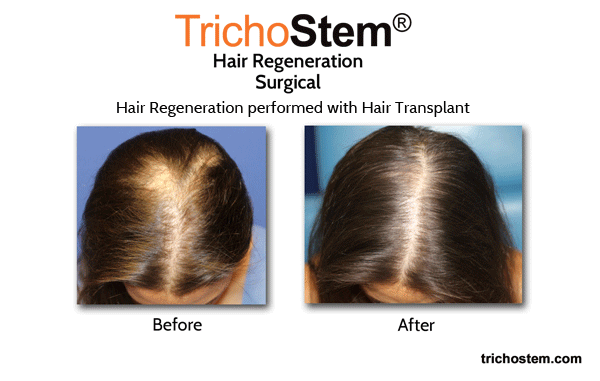
Only the completely bald area has transplanted hair, while the surrounding hair throughout the hair is thickened with TrichoStem® Hair Regeneration, which also prevents future hair loss.
Managing Further Hair Loss
Hair transplant does not do anything to prevent or manage future hair loss. People assume hair transplant is a solution for hair loss but are often not fully informed of the reality of ongoing hair loss. In men with hair loss, genetics and DHT-sensitive hair results in hair becoming thinner with each hair growth cycle until they disappear completely. Although Hair Regeneration does not appear to affect DHT directly, TrichoStem® Hair Regeneration does stimulate existing hair to grow and become thicker. TrichoStem® Hair Regeneration appears to achieve this through by increasing the production of your own adult stem cells to promote hair growth at the roots of the hair follicles. Synergy between DHT reduction and TrichoStem® Hair Regeneration may be an optimal strategy in some situations.
Delaying Future Transplants
The majority of TrichoStem® Hair Regeneration patients are able avoid hair transplants for the time when they have treatment. People who’ve previously undergone hair transplant patients can receive similar benefit. The hair transplant industry thrives on “repeat business”, and many first time hair transplant patients are not informed they will likely spend thousands more on additional transplants down the road. Since hair transplants on their own impact future hair loss, a transplant patient’s hair density will only last so long before their native hairs thin and is lost. To avoid the obvious “pluggy look”, many patients feel they have little option but to have more hair transplants until their donor area is tapped out.
By treating the hair thinning process, TrichoStem® Hair Regeneration effectively improves the appearance of the scalp in over 99% of male patients. If hair grows gradually thicker, and maintains its thick quality over the years, further hair transplants can be avoided. Currently, many of the earliest patients of TrichoStem® Hair Regeneration have passed the 5 year mark, and no trends of hair regressing to a thinned state have been observed. Even if TrichoStem® Hair Regeneration is only effective for fewer years, reapplication of the injection treatment is far more convenient than undergoing another expensive, long hair transplant that offers only diminishing returns, with a virtual guarantee that results won’t last.
As the years go on, TrichoStem® Hair Regeneration patients are continuing to enjoy the confidence of thicker hair that came from treatment done years prior.
Get your hair restoration questions answered so you can help your hair loss now. Contact us at (212) 265-8877 in Manhattan, or (516) 742-4636 in Garden City, Long Island, or at our new location in Vienna, Virginia at (703) 356-1336 or (703) 821-2683
